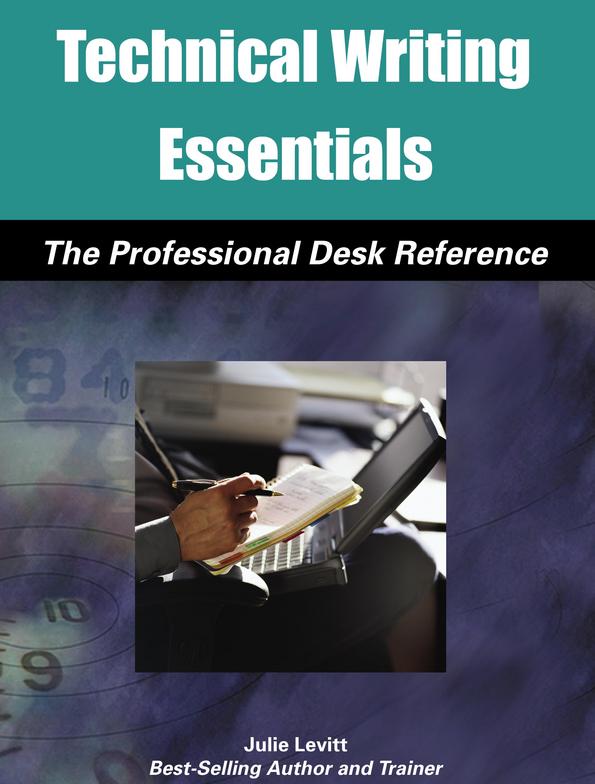Technical Writing
Essentials
Intended For
This course is
intended for people seeking to develop or improve effective
technical writing skills at the beginning or intermediate
levels.
Prerequisites
Participants are
expected to be well experienced in basic grammar and writing
skills, including sentence and paragraph development, spelling, and
punctuation.
Primary Goal
The primary goal
of this course is to review and practice writing techniques for
making any technical content easy to read, understand, act upon,
and remember. Special emphasis is given to techniques for
writing clear instructions and procedures.
Learning
Objectives
- Analyzing and
identifying audience needs effectively
- Organizing
technical content to covey the message clearly and
logically
- Identifying
information types, selecting the best corresponding presentation
style for each, and organizing the content in logical
sequencing
- Mastering
higher-level writing skills to improve correctness, clarity, and
professionalism of content (including use of active and passive
voice, parallel structure, clear pronoun references, avoidance of
subject and verb interruptions, and more)
- Writing clear,
usable instructions and procedures
- Designing an
effective layout and style guide for technical
documents
- Proofreading and
editing technical documents effectively
Comprehensive, Professional Book
Provided
Technical
Writing Essentials, by Julie Levitt is the 100-page book
provided for each course participant. This comprehensive
collection of easy tools to improve technical writing effectiveness
is both a learning tool and an efficient reference for future
use. The book reflects current business trends and
standards.
Contents for
Text-Workbook
Technical Writing Essentials
CHAPTER 1.
DEFINE THE TECHNICAL WRITING PROCESS
- Define Technical
Writing
- Define the
Technical Writing Process
CHAPTER 2.
PLAN: DETERMINE DOCUMENT PURPOSE, AUDIENCE, AND
REQUIREMENTS
- Determine
Document Purpose
- Analyze the
Audience
- Confirm Document
Purpose, Type, Scope, Requirements
CHAPTER 3.
RESEARCH, CLUSTER IDEAS, IDENTIFY READER BENEFITS, AND SELECT AN
ORGANIZATIONAL PATTERN
- Research
- Identify
Benefits to the Reader
- Consider
Developing a Content Planning Checklist
- Cluster and
Number Initial Content Ideas
- Select the Best
Organizational Pattern
- Develop a Rough
Outline
- Prepare a Formal
Outline
CHAPTER 4.
DRAFT AND MAP THE CONTENT
- Write the Rough
Draft
- Use Message
Mapping to Increase Readability and Usability (chunking, relevance
and uniformity, graphics integration, information types,
presentation methods, headings, visual language, action
tables)
- Revise the Rough
Draft
CHAPTER 5.
USE GRAPHICS TO CLARIFY DETAILS
- Choose the Right
Graphic
- Know Functions
of Tables, Graphs, and Charts
- Follow
Guidelines for Using Graphics
- Create Charts
Easily
CHAPTER 6.
WRITE CORRECTLY, COHERENTLY, AND CLEARLY
- Use Active and
Passive Voice Construction Skillfully
- Eliminate Dummy
Subjects
- Use Parallel
Structure
- Avoid
Camouflaged and Weak Verbs
- Avoid Subject
and Verb Interruptions
- Use Clear
Pronoun References and Agreement Use Specific, Measurable
Terms
- Use Simple,
Direct Terms, and Meet Multicultural Needs
- Use Transitions
to Increase Coherence
CHAPTER 7.
WRITE CLEAR INSTRUCTIONS AND PROCEDURES
- Match Content to
the Audience
- Analyze Tasks,
Test Usability, Evaluate Instructional Content
- Plan the
Content
- Pay Attention to
Organization and Logic
- Write Clear
Instructions
- Format
Instructions Clearly
CHAPTER 8.
DEVELOP AN EFFICIENT DOCUMENT DESIGN
- Plan and Apply a
Clearly Designed Layout
- Prepare and Use
a Document Style Guide
CHAPTER 9.
REVIEW KEY ELEMENTS OF SHORT REPORTS
- Short Report
Overview
- Components of
Short Reports
- Direct and
Indirect Format
CHAPTER 10.
REFINE YOUR DOCUMENT: PROOFREAD AND EDIT
- Use the
Three-Step Proofreading/Editing Method
- Improve
Proofreading Skills
- Use Standard
Proofreader’s Marks
- Edit to
Eliminate Errors in Missing or Incomplete Information
- Edit to
Eliminate Incorrect Facts or Contradictions
- Edit to
Eliminate Inconsistencies and Sequencing Errors
- Proofread for
Accuracy of Numbers
Supplemental
Technical Writing Essentials Resource Materials
Technical
Writing Essentials Appendix Items
- Course Writing
Project
- Template for
Planning and Organizing a Technical Document
- Basic
Flowcharting Fundamentals
- Technical
Writing Information Resources
- Final Technical
Document Checklist
Technical
Writing Essentials: Companion CD Supplements
- Template for
Planning and Organizing a Technical Document
- Using Numbers
Correctly (in figures or written out)
- Comparison and
Contrast Techniques
- International
Localization: Structure Problems to Avoid
- Citing Sources
in a Bibliography
- Basic Grammar
and Punctuation Elements
- Technical
Writing Strategies for the Web
- Revise Draft
Exercise
